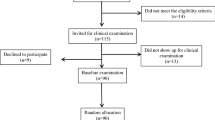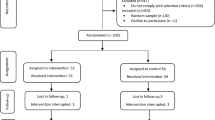Abstract
Objective
The aim of this study was to verify the influence of a specific exercise program on the strength and resistance levels of lumbar flexors and extensors in warehouse workers.
Materials and Methods
The population used in this randomized controlled trial included 557 warehouse male workers from a food distribution company in Oporto/Portugal. Upon the application of the selection criteria, 98 workers deemed eligible were randomized in two groups: 57 were assigned to the intervention group and 41 to the control group. The intervention included 9 easily-executed exercises to promote stretching and strengthening of the lumbar region, to be executed daily, at the beginning of the working time, at the company facilities and lasting 8′. Trunk muscles’ voluntary strength and resistance were measured using an isometric electronic dynamometer (Globus Ergometer, Globus, Codigné, Italy) at baseline and eleven months after implementing the exercise program. The data was analyzed using SPSS®, version 17.0.
Results
After implementation of the exercise program, in the intervention group, all variables increased, significant differences were observed as for the muscle strength and resistance values (p = 0.014 and p = 0.006, respectively), as well as in the ratio extensors/flexors (p = 0.037). In the control group, all variables decreased, with a statistically significant decrease of the trunk flexors strength level (p = 0.009).
Conclusion
The results of this study suggest that a specific exercise intervention program can increase trunk extensors strength and resistance.
Similar content being viewed by others
References
Rissanen A, Heliovaara M, Alaranta H, Taimela S, Malkia E, Knekt P, et al. Does good trunk extensor performance protect against back-related work disability? J Rehabil Med 2002;34(2):62–66.
Piedrahita H, Oksa J, Malm C, Rintamaki H. Health problems related to working in extreme cold conditions indoors. Int J Circumpolar Health 2008;67(2–3):279–287.
Lahiri S, Markkanen P, Levenstein C. The cost effectiveness of occupational health interventions: preventing occupational back pain. Am J Ind Med 2005;48(6):515–529.
Kent PM, Keating JL. The epidemiology of low back pain in primary care. Chiropr Osteopat 2005;13:13. PMCID: 1208926.
Galukande M, Muwazi S, Mugisa BD. Disability associated with low back pain in Mulago Hospital, Kampala Uganda. Afr Health Sci 2006;6(3):173–176. PMCID: 1831887.
Brox JI, Storheim K, Holm I, Friis A, Reikeras O. Disability, pain, psychological factors and physical performance in healthy controls, patients with sub-acute and chronic low back pain: a case-control study. J Rehabil Med 2005;37(2):95–99.
O’sullivan PB, Mitchell T, Bulich P, Waller R, Holte J. The relationship between posture and back muscle endurance in industrial workers with flexion-related low back pain. Man Ther 2006;11(4):264–271.
IJzelenberg W, Burdorf A. Impact of musculoskeletal co-morbidity of neck and upper extremities on healthcare utilisation and sickness absence for low back pain. Occup Environ Med 2004;61(10):806–810. PMCID: 1740669.
van Vuuren BJ, Becker PJ, van Heerden HJ, Zinzen E, Meeusen R. Lower back problems and occupational risk factors in a South African steel industry. Am J Ind Med 2005;47(5):451–457.
Piedrahita H. Costs of work-related musculoskeletal disorders (MSDs) in developing countries: Colombia case. Int J Occup Saf Ergon 2006;12(4):379–386.
Battié MC, Videman T, Gibbons LE, Manninen H, Gill K, Pope M, et al. Occupational driving and lumbar disc degeneration: a case control study. Lancet 2002;360:1369–1374.
Lis AM, Black KM, Korn H, Nordin M. Association between sitting and occupational LBP. Spine J 2007;16(2):283–298.
Bovenzi M, Zadini A. Self-reported low back symptoms in urban bus drivers exposed to whole body vibration. Spine 1992:17(9):1948–59.
Porter JM, Gyi DE. The prevalence of musculoskeletal troubles among car drivers. Occup Med 2002;52(1):4–12.
Wilder DG, Woodworth BB, Frymoyer JW, Pope MH. Vibration and the human spine. Spine 1982;7(3):243–254.
De Carvalho DE, Soave D, Ross K, Callaghan JP. Lumbar Spine and Pelvic Posture Between Standing and Sitting: A Radiologic Investigation Including Reliability and Repeatability of the Lumbar Lordosis Measure. J Manipulative Physiol Ther 2010;33(1):48–55.
Imamura ST, Kaziyama HD, Imamura M. Lombalgia. In: Teixeira MJ. Musculoskeletal pain. São Paulo: Rev Bras Med 2001. p. 375–390 [in Portugal].
Juul-Kristensen B, Jensen C. Self-reported workplace related ergonomic conditions as prognostic factors for musculoskeletal symptoms: the “BIT” follow up study on office workers. Occup Environ Med 2005;62(3):188–194.
Vuuren BJ, Becker PJ, Heerden HJ, Zinzen E, Meeusen R. Lower Back Problems and Occupational Risk Factors in a South African Steel Industry. Am J Ind Med 2005;47(5):451–457.
Lee J, Hoshino Y, Nakamura K, Kariya Y, Saita K, Ito K. Trunk muscle weakness as a risk factor for Low Back Pain: a 5-year prospective study. Spine 1999;24(1):54–57.
Norris CM. Spinal Stabilisation: 3. Stabilisation Mechanisms of the Lumbar SpineStabilization Mechanisms of the Lumbar Spine. Physiotherapy 1995;81(2):72–79.
Comerford MJ, Mottram SL. Movement and stability dysfunction-contemporary developments. Man Ther 2001;6(1):15–26.
Richardson C, Jull G, Toppenberg R, Comerford M. Techniques for active lumbar stabilisation for spinal protection: A pilot study. Aust J Phys 1992;38(2):105–112.
Sbriccoli P, Yousuf K, Kupershtein I, Solomonow M, Zhou B, Zhu MP, et al. Static load repetition is a risk factor in the development of lumbar cumulative musculoskeletal disorder. Spine 2004;29(23):2643–2653.
Arokoski JP, Kankaanpaa M, Valta T, Juvoren I, Partanen J, Taimela S, et al. Back and extensor muscle function during therapeutic exercises. Arch Phys Ther Rehab 1999;80(7):842–850.
Besler A, Can F. Correlation between pain, trunk muscle strength, and functional state in low back pain. Pain Clinic 2003;15(4):415–419.
Hodges PW. Is there a role for transverses abdominis in lumbo-pelvic stability? Man Ther 1999;4(2):74–86.
Peltonen JE, Taimela S, Erkintalo M, Salminen JJ, Oksanen A, Kujala UM. Back extensor and psoas muscle cross-sectional area, prior physical training, and trunk muscle strength - a longitudinal study in adolescent girls. Eur J Appl Physiol 1998;77(1–2):66–71.
Rissanen A, Heliövaara M, Alaranta H, Taimela S, Mälkiä E, Knekt P. Does good trunk extensor performance project against back-related work disability? J Rehabil Med 2002;34(2):62–66.
Roussel N, Truijen S, Breugelmans S, Claes I, Stassijns G. Reliability of the assessment of lumbar range of motion and maximal isometric strength. Arch Phys Med Rehabil 2006;87(4):576–582.
Byrne K, Doody C, Hurley D. Exercise therapy for low back pain: A small-scale exploratory survey of current physiotherapy practice in the Republic of Ireland acute hospital setting. Man Ther 2006;11(4):272–278.
Hicks GE, Fritz JM, Delitto A, McGill SM. Preliminary Development of a Clinical Prediction Rule for Determining Which Patients With Low Back Pain Will Respond to a Stabilization Exercise Program. Arch Phys Med Rehabil 2005;86(9):1753–1762.
Punnett L, Prüss-Ustün A, Nelson DI, Fingerhut MA, Leigh J, Tak S, et al. Estimating the global burden of low back pain attributable to combined occupational exposures. Am J Ind Med 2005;48(6):459–469.
Tveito T, Hysing M, Eriksen H. Low back pain interventions at the workplace: a systemic literature review. Occup Med 2004;54(1):3–13.
Lahiri S, Gold J, Levenstein C. Estimation of Net-Costs for Prevention of Occupational Low Back Pain: Three Case Studies From the US. Am J Ind Med 2005;48(6):530–541.
Moffett J, Carr J, Howarth E. High fear-avoiders of physical activity benefit from an exercise program for patients with back pain. Spine 2004;29(11):1167–1173.
Scannell JP, McGill SM. Lumbar posture-should it, and can it, be modified? A study of passive tissue stiffness and lumbar position during activities of daily living. Phys Ther 2003;83(10):907–917.
Van Poppel MN, Hooftman WE, Koes BW. An update of a systematic review of controlled clinical trials on the primary prevention of back pain at the workplace. Occup Med (Lond) 2004;54(5):345–352.
Mannion AF, Taimela S, Müntener M, Dvorak J. Active Therapy for Chronic Low Back Pain. Part 1. Effects on Back Muscle Activation, Fatigability, and Strength. Spine 2001;26(8):897–908.
O’sullivan P, Mitchell T, Bulich P, Waller R, Holte J. The relationship between posture and back muscle endurance in industrial workers with flexion-related low back pain. Manual Ther 2006;11(4):264–271.
Braggins S. Back Care - A Clinical Aproach. Londres: Churchill Livingstone; 2000.
Oddsson LI, De Luca CJ. Activation imbalances in lumbar spine muscles in the presence of chronic low back pain. J Appl Physiol 2003;94(4):1410–1420.
O’sullivan P, Mitchell T, Bulich P, Waller R, Holte J. The relationship between posture and back muscle endurance in industrial workers with flexion-related low back pain. Man Ther 2006;11(4):264–271.
Holmström E, Ahlborg B. Morning warming-up exercise effects on musculoskeletal fitness in construction workers. Appl Ergon 2005;36(4):513–519.
Robinson ME, Greene AF, O’Connor P, Graves JE, Millan MM. Reliability of Lumbar Isometric Torque in Patients with Chronic Low Back Pain. Physical Ther 1992;72(3):186–190.
Brown LE, Weir JP. ASEP Procedures Recommendation I: Accurate Assessment Of Muscular Strength And Power. J Exerc Physiol 2001;4(3):1–21.
Douris P, Chinan A, Gomez M, Steffens D, Weiss S. Fitness levels of middle aged martial art practitioners. J Sports Med 2004;38(2):143–147.
Pettersen J, Hölmich P. Evidence based prevention of hamstring injuries in sport. J Sports Med 2005;39(6):319–323.
Remaud A, Cornu C, Guével A. A Methodologic Approach for the Comparison Between Dynamic Contractions: Influences on the Neuromuscular System. J Ath Train 2005;40(4):281–287.
Rantanen P, Airaksinen O, Penttinen E. Paradoxical variation of strength determinants with different rotation axes in trunk flexion and extension strength tests. Eur J Appl Physiol 1994;68(4):322–326.
Rantanen P, Nykvist F. Optimal sagital motion axis for trunk extension and flexion tests in chronic low back trouble. Clin Biomech 2000;15(9):665–671.
Koumantakis GA, Watson PJ, Oldham JA. Supplementation of general endurance exercise with stabilisation training versus general exercise only Physiological and functional outcomes of a randomised controlled trial of patients with recurrent low back pain. Clin Biomech 2005;20(5):474–482.
McCarthy CJ, Callaghan MJ, Oldham JA. The reliability of isometric strength and fatigue measures in patients with knee osteoarthritis. Man Ther 2008;13(2):159–164.
Ebrahimi I, Hosseini GR, Salavati M, Farahini H, Arab AM. Clinical trunk muscle endurance tests in subjects with and without low back pain. Med J Islam Rep Iran 2005;19(2):95–101.
Ebben WP, Jensen RI. Strength Training For Women: Debunking Myths That Block Opportunity. Phys Sports Med 1998;26(5):86–97.
Gundewall B, Lilequist M, Hansson T. Primary prevention of back symptoms and absence from work. Spine 1993;18(5):587–594.
Moffroid MT. Endurance of trunk muscles in persons with chronic low back pain: Assessment, performance, training. J Rehabil Res Dev 1997;34(4):440–447.
Cohen NB, Narrow CM. Effective treatment of back pain. J Am Chirop Assoc 1999;36(6):22–26.
Quinn E. The Proper Use of Belts During Weight Training. Sports Med 2003:72–78.
Trainor TJ, Wiesel SW. Epidemiology of Back Pain in the Athlete. Clin Sports Med 2002;21(1):93–103.
Vital E, Melo MJ, Nascimento AI, Roque AL. Trunk muscle strength and back pain complaints in early adolescence. Rev Port Fisiot Desp 2007;1(1):4–11 [in Portuguese].
Author information
Authors and Affiliations
Corresponding author
About this article
Cite this article
Carvalho Mesquita, C., Ribeiro, J.C. & Moreira, P. Effect of a specific exercise program on the strength and resistance levels of lumbar muscles in warehouse workers. IJOMEH 25, 80–88 (2012). https://doi.org/10.2478/s13382-012-0011-0
Received:
Accepted:
Published:
Issue Date:
DOI: https://doi.org/10.2478/s13382-012-0011-0




